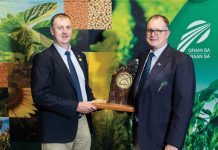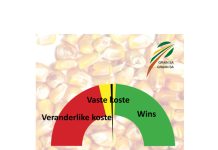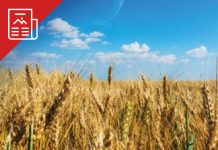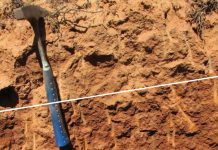Soil does not form by chance, but as a result of the influence of climate, organisms and topography on the parent material over time. The result of these five soil formation factors are responsible for the formation of a unique soil type at a specific place.
The soil formation factors control, in turn, the soil formation processes that determine which horizons (layers in the soil) form in the soil. It is these horizons that eventually determine a soil’s unique properties and thus the land usage.
This article focuses on the soil formation factors and forms part of a series that highlights this resource.
Parent material
Parent material may be regarded as the matrix or the building block of soil, because soil develops out of the local unconsolidated, weathering of rocks or sediments. Various parent materials give rise to a variety of weathering products and therefore a variety of (primary) mineral particles which develop into a specific type of soil.
The parent material therefore has a major impact on the soil characteristics, especially when the soil is in an early development stage. If the parent material is known, this information can then be used to deduce the probable characteristics of a particular soil. (The various types of rocks, their mineral composition and the influence they have on the soil characteristics, were discussed in Part 2 of this series).
Climate
Rainfall and temperature are the most important elements of climate influencing soil formation, as they determine the rate of weathering. In deserts (hot and dry) or the tundra (cold and wet), soil develops slowly, while it develops rapidly in the tropics (hot and wet). When an area’s climate is hot and dry, the soils are shallow, not significantly leached and has a low organic material content. When it is hot and wet, the soils are deeper, more leached and contain more organic material.
The effect of rainfall on the soil formation process is determined by the type and intensity of the rain, the distribution over seasons, the rate of evaporation, the aspect of the terrain (for example northern or southern slope) and the porosity of the parent material.
The water that is available for soil formation, is determined by the ratio between the average annual rainfall (P, mm) and evaporation (E, mm). The higher the P/E ratio, the more intense the leaching and removal of soluble salts and plant nutrients from the soil; the more intense the weathering of minerals will be and the greater the amount of clay that will be leached to the deeper horizons and lower down in the landscape.
The rate of weathering and soil formation reactions doubles with about every 10°C increase in soil temperature.
However, there is a strong relationship between rainfall, temperature and soil formation. Dry, hot desert conditions and cold, wet tundra conditions, are not conducive to soil formation, while intense soil formation and weathering occurs under wet, tropical conditions.
Organic material will increase with increasing soil wetness, leaching will increase, pH decreases, base saturation decreases, acid saturation increases, clay minerology changes from 2:1 to 1:1, CEC decreases, fertility decreases, underground saturation increases, and more water is available for plant growth.
With an increase in temperature, while the rainfall remains constant, the effective rainfall will decrease, organic material content decreases, and weathering of clay minerals will increase from 2:1 to 1:1.
Organisms
All the organisms living in or on the soil influence soil formation. Plant roots bind soil particles together and, in doing so, lower soil erosion. The same process also helps with the formation of crumbly and granular structure. The thick roots of trees thicken and therefore mix the soil in this way. Plant roots can also contribute to physical weathering by breaking up the rock. When the roots die, organic material remains behind and when that weathers, it leaves channels which improve aeration and water movement in the soil.
Plants also provide the soil with organic material – on the surface through leaves and in the soil by roots. Although trees provide a lot of organic material when they die, it is the perennial plants such as grasses which provide the most organic material per annum. The plant cover also protects the soil against raindrop impact and, in so doing, limits erosion. It also reduces the soil temperature, thus lowering evaporation.
In the natural ecosystem, plants absorb nutrients from the soil and replace them with organic material. This is a very delicate balance and may easily be disturbed through the removal of plants via, for example, the exploitation of tropical rain forests, overgrazing or cultivation, where crops are removed from the land.
Mesofauna, such as earthworms, nematodes, mites, termites, ants, centipedes and other insects, are normally found in the topsoil, where organic material is concentrated and the soil is well aerated.
The majority of these animals cannot survive in wet, water saturated soil. Mesofauna change the soil by secreting organic material and minerals in a digested form. These secretions are usually more stable than the rest of the organic material of the soil. They therefore lead to an improved soil structure.
These animals mix the soil through their constant movement and tunnels that are excavated. The tunnels and structure improve the movement of air and water in the soil.
The majority of mammals live above the soil, but a small number, such as rats, moles and rabbits also live in the soil. These animals can tunnel deeply into the soil and thus mix the soil. They also take organic material into the soil, where they store it as food or nesting material. Animals are therefore responsible for the mixing of the soil, the addition of organic material and improved aeration through tunnels.
Uncontrolled utilisation of the plant cover through grazing can lead to the total exhaustion of the plant cover. This leads to reduced water infiltration, increased run-off and therefore increased erosion.
Man also influence soil formation through land use, for example through tillage, grazing, urban development, mining and forestry. Crop production also mixes the soil by means of tillage, organic material is removed and the fertility changes drastically. Man can therefore degrade the soil through overutilisation, but can also artificially create soil through, for example, the reclamation of mine dumps and the seafloor.
Topography
Topography refers to the shape of the earth’s outlines. In particular, it is the slope and aspect of the local relief that are important to soil formation.
Slope refers to the angle between the earth’s surface and an imaginary horizontal line, while slope position refers to the specific position on the hillside (Figure 1). Aspect is the compass direction of the slope (e.g. north or south), and slope is measured downwards crossing the contour lines.
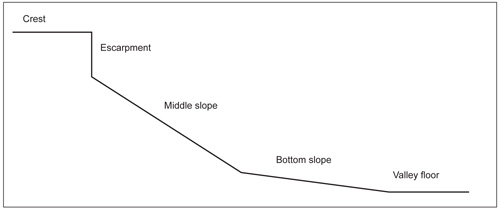
Topography influences soil formation by the effect it has on the microclimate, plant growth, parent material and time. The physical shape of the landscape determines how, and how much soil and water is redistributed. Flat areas are, for example, more susceptible to wind erosion, while water erosion has the major impact in steep areas.
Soil in crest positions usually forms in situ (right there from the parent material), is older and shows signs of advanced weathering and leaching. Escarpments are too steep for any soil to form as all the soil is lost to erosion.
Soils on the mid-slopes are usually deep and well-drained. Soils on the foot-slopes are more poorly drained than those on the mid-slopes and signs of wetness are common. Poorly drained soils are common in the valley bottoms, where soil forms in alluvial deposits. This succession of soils in a slope is referred to as a catena or an hydrological topo series.
Time
Soil formation is a very slow process. It can take several thousands or millions of years. The longer a soil is exposed to a specific set of soil formation processes, the more prominently the soil properties develop.
The combination of soil formation processes that are dominant, will determine how long the soil takes to become “mature”. Because soil formation is such a slow process, it can take place under a variety of climatic conditions, as the climate has changed a number of times in the past.
When the climate changes, the soil will also change. A soil that has developed under a previous climatic cycle, is known as a palaeosol (palaeo = old; sol = soil) or primary soil. A soil reaches maturity when soil formation and soil destruction (erosion) take place at the same rate. The degree and depth of horizon differentiation is also an indication of the age of the soil.
Summary
The five soil formation factors – parent material, climate, organisms, topography and time – control the soil formation processes and thus determine which soil forms in a particular place. In many cases, the type of soil may be deduced from the specific set of soil formation factors. However, this takes experience and should be done with circumspection and should always be verified.
For further information, please contact the authors on:
Martiens du Plessis: martiens@nwk.co.za
Prof Cornie van Huyssteen: vanhuyssteencw@ufs.ac.za
REFERENCES
Brady, NC. 1990. The nature and properties of soils. 10th ed. Macmillan Publishing Company: New York.



